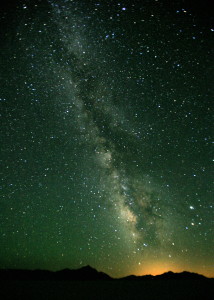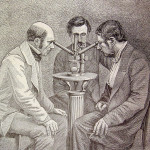Posted by Roberta Grimes • October 27, 2018 • 19 Comments
Afterlife Research, Human Nature, Quantum Physics, Understanding Reality
 It has been a little while since we last took a swipe at the Luddite field of scientific inquiry, but I keep finding on-point articles. Please indulge me while I share another of them now.
It has been a little while since we last took a swipe at the Luddite field of scientific inquiry, but I keep finding on-point articles. Please indulge me while I share another of them now.
The reason why I call my radio show and podcast Seek Reality is that everyone should be doing just that! Of what value are our attempts to make sense of things unless we conduct open-minded research and we don’t just look for evidence that might support our preconceived beliefs?
Amazingly, a full century after the university departments and the peer-reviewed journals first adopted materialism as what they then called “the fundamental scientific dogma,” scientists remain bound by materialism. And incredibly, the pointless battles over the nonsense beliefs of both science and Christianity that began more than a century ago still continue! Both disciplines are sure that their two sets of beliefs cover the range of all the possible ways that people might look at reality, and the battle between these two sets of beliefs – you might call them materialism and theism – would be laughable if it were not so ridiculous. Rather than battling over whether or not evolution happens, wouldn’t it be more productive for both scientists and religionists to share information and attempt to better understand reality together?
There is in fact a gigantic and readily available body of evidence of what actually is going on! We talk about pieces of that evidence here, and also on Seek  Reality, and nearly all of it is both scientific and spiritual – indeed, matter is in fact spirit – so all this information is off-limits to science. And since it doesn’t fit the Christian dogmas, religionists won’t touch it either. But it really is possible for us to figure out what actually is going on! And many researchers already have figured it out, to the extent that we can make sense of things with the limited minds that we bring into these bodies. So many people do indeed know the truth, and that makes watching the battle that continues between two failed and clueless ideologies a spectator sport that has moved beyond sad toward becoming ever more ridiculous.
Reality, and nearly all of it is both scientific and spiritual – indeed, matter is in fact spirit – so all this information is off-limits to science. And since it doesn’t fit the Christian dogmas, religionists won’t touch it either. But it really is possible for us to figure out what actually is going on! And many researchers already have figured it out, to the extent that we can make sense of things with the limited minds that we bring into these bodies. So many people do indeed know the truth, and that makes watching the battle that continues between two failed and clueless ideologies a spectator sport that has moved beyond sad toward becoming ever more ridiculous.
Let’s look in particular at what we experience as human consciousness, which is the core energy that continuously manifests this universe. Independent researchers have learned quite a lot about consciousness, and we would be happy to share! But scientific dogmas still preclude that. Scientists have spent the past century trying to figure out how the brain generates consciousness, which is the rough equivalent of a gaggle of primitives clustered around a radio trying to figure out how those tubes and wires generate the voice of Frank Sinatra. Consciousness used to be called “the hard problem,” and for a long time scientists seriously sought a source of consciousness in the brain, without success. So of late they are just winging it.
For example, two purported researchers have authored an article in the current issue of Scientific American entitled “Unlocking the ‘Mystery’ of Consciousness” that they claim will explain consciousness while requiring neither “supernatural intervention” nor “any new fundamental physics.” So they claim to have beaten the religionists – “Take that, Christianity!” – while at the same time they are respecting a physics that is grounded entirely in materialism.
 I began to read this article with some enthusiasm! Could this be the long-awaited breakthrough? Alas, no. It is eighteen paragraphs of unsupported nonsense. After an introduction that uses big words but says nothing, the authors go on to claim that “consciousness and the creation of feelings are fundamentally grounded in general life functions. Just look at all the basic commonalities between life and feelings. For instance, both rely on complexly organized chemical and physiological processes, and both are embodied; that is, each living thing has a body with a boundary from the outer world. So just as life requires a bounded body for survival, consciousness requires such a body for the creation of a personal (first-person) point of view.” Even if this statement were supported by evidence, it still brings us no closer to understanding the origins of consciousness in the brain. Comparing the origin of consciousness with the origin of life is particularly useless when scientists don’t understand that, either!
I began to read this article with some enthusiasm! Could this be the long-awaited breakthrough? Alas, no. It is eighteen paragraphs of unsupported nonsense. After an introduction that uses big words but says nothing, the authors go on to claim that “consciousness and the creation of feelings are fundamentally grounded in general life functions. Just look at all the basic commonalities between life and feelings. For instance, both rely on complexly organized chemical and physiological processes, and both are embodied; that is, each living thing has a body with a boundary from the outer world. So just as life requires a bounded body for survival, consciousness requires such a body for the creation of a personal (first-person) point of view.” Even if this statement were supported by evidence, it still brings us no closer to understanding the origins of consciousness in the brain. Comparing the origin of consciousness with the origin of life is particularly useless when scientists don’t understand that, either!
The authors go on to say, “to these general features are added numerous and neurobiologically unique special neurobiological features of complex nervous systems, especially of complex brains, that all together create consciousness. The special neurobiological features that we identified include an explosion of senses (eyes, good hearing, keen smell), a multitude of new neural processing subsystems, more combining of information from the different senses, more levels of information processing at the top of the brain, more back-and-forth communications between brain levels, and more memory. From these neural features arise consciousness in a way comparable to how the complex property of life naturally arises from the interactions of its chemical and cellular components.” Since these authors show no interest in understanding how our sensory organs relate to conscious experience, and since scientists still have not figured out how life arises, all of this means precisely nothing. It is the equivalent of saying, “Whenever you have tubes and wires you are going to give rise to somebody’s voice, whether it’s Frank Sinatra’s or Kanye West’s. But we don’t know why!
And there is even more of this blather. The authors go on to say, “So the solution to the ontological aspect of the explanatory gap is that all feelings are both uniquely personal via their connection to life, and they have a unique neurobiology through the special features. And the two in combination create the unique feature of conscious feelings. Note this explanation requires no supernatural intervention nor any new ‘fundamental property’ or principle of physics.” It seems that for them the entire point is to figure out a way to support traditional physics while excluding “supernatural intervention”!
the ontological aspect of the explanatory gap is that all feelings are both uniquely personal via their connection to life, and they have a unique neurobiology through the special features. And the two in combination create the unique feature of conscious feelings. Note this explanation requires no supernatural intervention nor any new ‘fundamental property’ or principle of physics.” It seems that for them the entire point is to figure out a way to support traditional physics while excluding “supernatural intervention”!
And without offering any support for their theories, the authors insist on making the point that how ever consciousness might arise in the brain, the ability for the brain to generate consciousness must have evolved. They say, “We support our natural solution to the ontological subjectivity of primary consciousness by showing that there is no gap in the evolutionary sequence that led from life to feelings.” “Take that, all you religionists who don’t believe in evolution!” They add, “However, while there was a seamless and natural evolution of consciousness, we also find that feelings and their neural substrates are extremely diverse and widespread. This is true within a brain: in mammals, for example, the brain areas for the many kinds of perceived images (cerebral cortex) largely differ from those for the many kinds of affects or emotions (subcortical areas).” Again, not a bit of scientific evidence or insight into how any of this is even relevant to our core inquiry about how the brain gives rise to consciousness. Or how a primordial goo gives rise to life.
 These authors’ conclusion is perhaps their most amazing bit of nonsense. They simply say, “We conclude that the “mystery” of consciousness and Levine’s “explanatory gap” and the “hard problem” can be naturally and scientifically explained. Our theory hinges on the propositions that consciousness and subjective feelings can be ontologically subjective and neurobiologically unique yet scientifically explainable, and that this creates an unbridgeable yet scientifically unproblematic divide between first- and third-person knowledge of the brain. At the same time, it continues to explain how while subjective experience is unique in nature, there is no need to invoke unknown forces, either physical or nonphysical, to account for its creation.” To this day, scientists cannot even explain what consciousness is, nor can they come up with a workable theory of how it arises in the brain. But rather than allowing such baseline quibbles to trip them up, these authors have gone on to assume that consciousness must somehow arise in the brain and then constructed a whole set of nonsense theories that use multi-syllabic terms but are supported by no evidence and explain nothing. This is what passes for scientific rigor today!
These authors’ conclusion is perhaps their most amazing bit of nonsense. They simply say, “We conclude that the “mystery” of consciousness and Levine’s “explanatory gap” and the “hard problem” can be naturally and scientifically explained. Our theory hinges on the propositions that consciousness and subjective feelings can be ontologically subjective and neurobiologically unique yet scientifically explainable, and that this creates an unbridgeable yet scientifically unproblematic divide between first- and third-person knowledge of the brain. At the same time, it continues to explain how while subjective experience is unique in nature, there is no need to invoke unknown forces, either physical or nonphysical, to account for its creation.” To this day, scientists cannot even explain what consciousness is, nor can they come up with a workable theory of how it arises in the brain. But rather than allowing such baseline quibbles to trip them up, these authors have gone on to assume that consciousness must somehow arise in the brain and then constructed a whole set of nonsense theories that use multi-syllabic terms but are supported by no evidence and explain nothing. This is what passes for scientific rigor today!
Open-minded people have known for a century that consciousness is not  generated by the brain, but rather it is the base energy which continuously manifests this universe. In a more enlightened future day, credit for this most important discovery of the twentieth century will go to Max Planck, who in 1918 won the Nobel Prize in physics as the father of quantum mechanics. Back in 1931, Planck said, ”I regard consciousness as fundamental. I regard matter as derivative from consciousness. We cannot get behind consciousness. Everything that we talk about, everything that we regard as existing, postulates consciousness.”
generated by the brain, but rather it is the base energy which continuously manifests this universe. In a more enlightened future day, credit for this most important discovery of the twentieth century will go to Max Planck, who in 1918 won the Nobel Prize in physics as the father of quantum mechanics. Back in 1931, Planck said, ”I regard consciousness as fundamental. I regard matter as derivative from consciousness. We cannot get behind consciousness. Everything that we talk about, everything that we regard as existing, postulates consciousness.”
There were other twentieth-century physicists, too, who saw in the implications of quantum mechanics the fact that consciousness has to be primary! Physicist Euan Squires said, “Every interpretation of quantum mechanics involves consciousness.” Physicist Sir James Jeans said, “The universe begins to look more like a great thought than a great machine.” And the evidence for the primacy of what we experience as human consciousness is by now so incontrovertible and complete that it is hard to see how it might be disputed by anyone who has access to objective facts. If only scientism and religionism would at last declare a truce in these battles that neither of them can win, then perhaps we all might seek reality together and share the objective truth with all of humankind.
Meanwhile, these nonsensical battles between scientists and religionists go on! Next week we will consider their ongoing major bone of contention, which is the theory of evolution vs. the theory of creation. There is in fact an evidence-based way to make sense of how things happened, and brand-new evidence suggests that this third way may well be right….
Roberta, All that you wrote here is true, and that speaks badly most especially about the ridged prejudice of materialism. Sometimes quantum physicists will appear to have broken from materialism when the say such things as consciousness is involved in quantum phenomena– but they are not referring to consciousness as a phenomena separate from the brain. The point they are making is a trivial observation about the quantum wave function as indeterminate until the mind of a physicist decides to measure a quantum entity, such as an electron, and forces it to become real as an electron (or photon, or really any quantized entity), as a collapse of its Schrodinger wave equation representation to a particular observed value. What’s so remarkably stupid about this idea is to presume that quantum entities are not themselves ever interacting until a human observer intervenes.
It may also be seen that physicists have avoided confronting the issue that quantum entanglement defies materialism, what Einstein had called “spooky action at a distance.” He realized that the accepted formulation of quantum mechanics by the Schrodinger wave equation predicted that the quantum elements of a specific quantized system would be able to communicate instantaneously with each other across any distance, even 14 billion light years or more. HIs objection was that Special Relativity limited communication to the speed of light– fast, but not instantaneous. He further objected that there was no physical mechanism theorized to possibly explain how such communication could possible manifest. However, there are now hundreds of experiments that demonstrate that spooky action at a distance is a valid prediction by quantum mechanics. Materialism is obviously incapable of explaining how communication can be instantaneous across any distance.
Likewise, as you clearly stated, scientists who are hung up on materialism cannot fathom that consciousness exists even when the brain has gone dead. I had searched for years for an explanation of what philosophy and psychology term the qualia issue– how the brain is able to differentially perceive colors, sounds, fragrances, motion… when there are no observable brain structures or processes to account for such basic qualitative differences in perceptual phenomena (different areas of the brain specialize in different types of sensory input, such as from the eyes and ears, but the neural structures do not appear to be different according to their sensory input). I finally discovered the explanation while studying the Near Death Experience research literature.
A reliably reported experience is that at the instant of trauma, such as a vehicle collision or heart attack, perception may not stop or even get interrupted, but the perspective shifts its location during the Out of Body Experience induced by the trauma. The OBE perspective comes as a surprise, because after the OBE occurs they may not immediately realize the trauma has disconnected perception from what the eyes were looking at to what their disembodied consciousness then perceives. What that tells us is that conscious perception was never in the brain, although it was informed by the body’s sensory mechanisms. The fact that conscious perception may not by uninterrupted at the instant of trauma implies that it was not being produced by the brain.
Dear Jack, of course I agree with everything you say! Thank you for discussing it in more scientific terms, since I have never taken even a high school physics course. And thank you for commenting so quickly! I thought this article was so ridiculous that i had to share it the way one would share a good joke, but after it was posted I realized that it was pretty much as boring as all scientific literature is designed to be boring. I am reassured to see that at least you have found it funny, too!
Actually, I encountered the “spooky action at a distance” problem back in the eighties, while I was in my years-long binge of obsessively reading late-nineteenth and early-twentieth-century communications from the dead received primarily through deep-trance mediums. The physics that prevails everywhere beyond this material universe – which is to say, in most of reality – is quantum physics. Everything is created by thought, and travel by thought across the entire physical universe is instantaneous. Wow, what a puzzler that was! I accepted it as true, since all the testimony was consistent; but I had no idea how to make sense of it or how it might fit with this material universe.
So my first quantum-physics-for-dummies book was a revelation! It was Quantum Enigma by Bruce Rosenblum and Fred Kuttner, and it didn’t come out until 2011. I urge everyone to read that book! By the time it was published I had come to understand a great deal more, and I had defined for myself the alternative physics that governs most of reality. Now here was a book that explained that what I had independently discovered and defined was actually quantum physics! Boy, did i dance around the room with delight that day ;-).
The problem with all this is that people (especially scientists) insist on trying to explain phenomenon in terms of material world physics. This can’t happen because the quantum world is vastly different from the physical world. We have just barely scratched the surface of the quantum world, and even Einstein was perplexed by his own findings. James Jeans, a brilliant scientist, was right when he said the universe appeared more like a great thought. We need to get away from the thousands of theories that are out there that are based strictly on materialistic science and instead ask who or what is doing the thinking?
Dear Lola, this is a great insight! WHO is doing the thinking, indeed? I am deep in trying to understand that now, and I believe I am making some progress, but I would love to hear how you and others who can see the truth are beginning to explain the Thinker. Here are a few of my own ideas:
1) All of reality is continuously being manifested as we experience it. In other words, there is only Now. I don’t understand the details, but I am confident this is true.
2) Reality as we experience it has the basic components of a thought – e.g. it has no size, no time, and no place. It seems solid and real, but in fact it is ephemeral.
3) Every human mind is inextricably part of the eternal Mind that continuously manifests reality. Our minds are fully as powerful as the base creative Mind – the Thinker – but we don’t understand this so we don’t believe it is true.
4) And fortunately, the more we advance spiritually, the more we work in seamless unity with others and the less we have any interest in anything but effecting even further union! So those whose minds are powerful enough that they really could go rogue, won’t go rogue.
– That is just four thoughts inspired by what you have said. I have further notes, and “What God is” has been on my list of possible blog post titles for a long time, but I still don’t really know enough to write that post!
https://youtu.be/7_mSPxColVI
Here is a link to a short documentary by Anthony Chene (a little less than an hour, worth the time) that begins to address this face off. It’s about NDEs but also touches on the scientism vs. religionism questions. I like what one interviewee says about science being at a tipping point similar to explaining whether the earth is flat or round. They are ready to do it, but they don’t yet have the tools or language to do it. Note: I don’t own the rights to this documentary and if people object to its posting here, please take it down.
Thank you dear Mike! Since it came from the Zammits’ newsletter I think it must be fine!
The only thing I would say in caution is that those who are dead and speaking from the afterlife tell us consistently that those who have returned to life were never actually dead – they tell us that death is always a one-way trip – so even though many of those who have NDEs will say “I died,” in fact they did not die. They came close, and they were out of their bodies and having extraordinary experiences in the astral, but they were never where the dead actually go!
The reason this is important is that NDEs are highly personal – they are meant specifically to aid the person experiencing them – so all sorts of things happen in them that never happen in a genuine, planned death, or in the genuine afterlife. In fact, all natural deaths are remarkably uniform! They never include a tunnel and light (that seems to be a rescue device), they include no religious symbols or figures, they are never hellish (about one in seven NDEs is hellish), and God emphatically never appears and never speaks to anyone, ever (the dead confirm this). With these caveats, though, we can learn a lot from NDEs! Foremost, perhaps, is the fact that our minds so easily function when they are spatially far from our physical bodies and in fact even when our bodies are moribund and unable to support life without medical help. With these caveats, enjoy!
PS- For the purposes of this line of comments, it’s the interviews that talk about science and taboos that are most relevant.
Nice job Roberta. I always think of the middle age question: How many angels can dance on the head of a pin. Talk about nonsense and a waste of intellectual effort.
I like your REPLY post of 10/28- 2:44 P.M.
Thank you, Rick! It really has been frustrating to watch mainstream physics as a discipline decline into utter irrelevance over the past 20 years. I was so sure the light was about to dawn that I began to subscribe to Scientific American so I could watch it happen! But all that has happened in 20 years has been the devolution of the entire discipline. I mean, when someone who has never taken a class in physics can read about some puzzle they are wrestling with – dark matter, or consciousness or whatever – and can give them suggestions about how their thinking is wrong, then serious scientists have devolved into silliness!
And perhaps I shouldn’t be such a pedant about NDEs, but the belief is now too commonly held that NDEs actually can tell us details about the death process and the afterlife, when that is so completely not true! Sadly, though, some NDE experiencers get pretty cranky with me whenever I point this out ;-).
Yes, I always thought that NDE’s appeared to be staged in some way – for instance, a guy in Rowanda was declared dead and saw a biblical like figure with a giant chocolate bar who told this “dead” person that it represented the 10 commandments and that he should eat it in order to be saved. The guy eventually recovered and became a Christian minister. This was definitely a staged experience, and I can’t believe that he fell for it but he did. There are others I read about that aren’t as silly as this one, but they seem to be created somehow for the individual. It’s kind of scary because I don’t have a clue what the purpose behind this “staging” could possibly be.
Oh, wow, that is a weird one!
Dear Lola, they all are pulled from the mind of the experiencer this way. But they are extraordinary experiences – they FEEL extraordinary, and they stay vivid in the mind forever – so they feel like messages from God. I am convinced that some of them are indeed messages from our primary guides, but most of them seem to be in the nature of vivid dreams: the symbols and details are pulled from the experiencer’s mind, and they seem not to mean much of anything.
The key point about NDEs is that they prove without question that our minds easily exist apart from our bodies. They prove, moreover, that mindsight and mindhearing exist, since those who are blind or deaf from birth can see and hear during NDEs. And since perhaps 5% of Americans have had NDEs, they are common enough that they really can’t be ignored! They are wonderful, but they are not related to death so we can learn nothing from them about death at all.
Maybe some of them are extracted from our minds, but I watched the video as suggested by Mike (see above) that included a lady who had an NDE during which she saw a female being working on a laptop computer. This was in 1958 and she had no idea what this was. The being told her she would see these in the future and she did, of course, but it was decades later. I had read this account several times before. This couldn’t have come from her mind since no one in 1958 would have had the slightest clue what a laptop was. Since I can’t imagine anyone actually needing pa laptop computer in the afterlife LOL, I have to assume that this was a staged experience.
Yes indeed, in some NDEs the experiencers will see the past or the future as if it were currently happening. This is easy, since once we are out of this physical reality – which even scientists know is less than 5% of what actually exists – there is no objective time. It is therefore laughable easy for someone in 1958 who was being shown something happening on earth to have been shown a future event that included a laptop being used. It didn’t even need to be a staged experience!
Some may be extracted by our mind, but I watched the video as suggested by Mike (see above), and one of the NDE’s was about a woman who saw a female being working on a laptop computer, and she was told that she would see these in the future. Since this was in 1958, no one had ever seen a laptop because they weren’t invented yet. Also, it is difficult for me to believe that anyone needs a laptop computer in the afterlife (LOL), so I have to assume this is a staged experience.
Ach! I wish I hadn’t posted that video now. This is not a blog entry about NDEs — and the point of my posting that link was that there are people who are beginning to study and talk about the science of consciousness in a different way. The documentary is actually three years old, and since then, even more scientific investigation as to the nature of consciousness (outside of NDEs) has taken place. There is probably a better video than the one I posted to demonstrate the progress being made in consciousness investigation. People like Bruce Greyson, Pim van Lommell and people at the Institute of Noetic Sciences are out in front of this research. The point is, it is losing what Dean Radin (interviewed in the linked video) calls the “woo woo factor.”
Yes indeed, the study of consciousness is gradually becoming a lot more mainstream. And there is a new book out called An End to Upside Down Thinking by a young techie named Mark Gober that is likely to open many more eyes. I will be interviewing him on Seek Reality in a month or so. Dean Radin is an old and wonderful pioneer in this field – his work has been indispensable! But Mark’s book is being widely promoted. My hope is that it might become an entry to all the other wonderful consciousness research that already has been done!
Can’t wait to read “An End to Upside Down Thinking.” Thanks for posting it, Roberta. I know I was a bit off track when I mentioned the NDE about seeing a computer that didn’t exist yet, but for some reason, this set my heart racing.
Roberta I guess I have to take issue with thoughts on nde. I have read a great deal about nde s and find that the information these people tell us hard to believe is staged. One example is a little boy named Burpo who said he went to heaven and after his return told his parents things that only they knew and were never spoken about eg: he met his sister who had died prior to him being born. Several persons from a scientific back ground had nde s and the information they revealed also told of fantastic things. I am not easy to convince about things that appear to be out of this world. When you look at the combined evidence of most of the nde s they all relate to a similar event. I do believe God has the ability to do what ever he feels is necessary to get his point across and if nde s are the way he works with some people well that is it. I don’t think we give God enough credit for this type of experience.
Jim, I’m not sure what it is that you want NDEs to be, but here is what is objectively true:
1) EVERYTHING is “staged.” Nothing is objectively real other than the infinitely powerful and infinitely loving Mind that Jesus spoke of as Spirit. That Mind is all that really exists! It is the genuine God, just as Jesus said that It was. The cranky anthropomorphic Christian God and any kind of God that interferes personally with our lives flat-out do not exist. (Instead, we all are part of God, and God works in our lives primarily through spirit guides and helpers who also are part of God. It’s a distinction without much of a difference.)
2) NDEs genuinely happen. Our minds easily separate from our bodies, and they have real experiences as much as anything is a real experience. Many people meet siblings who died young or miscarried, of whom they were unaware; many people meet with wonderful beings who give them extraordinary information that they could not have gained otherwise. Some enjoy beautiful vistas and traverse the universe! NDEs are extraordinary and life-changing.
3) But NDEs are not death. Those that we used to think were dead tell us that death ALWAYS is a one-way trip. Just as importantly, an actual, planned death is amazingly uniform worldwide, and the process does not even resemble an NDE; perhaps most notably, there is no religion practiced in the afterlife, which is how you know that the little boy’s NDE with a throne room and so on was all staged for him. And that is typical! When people are going to come back to their bodies, and especially when they are religious children, it is notable that the beings who lovingly help them through their NDEs will often pull religious imagery from their minds as a way to comfort them. But it is not real, and it bears no resemblance to what actually happens in a normal death.
4) The reason it should be very important to all of us to keep a careful distinction between NDEs and normal death is that NDEs are often tinged with religious imagery. When the truth is that there is no religion practiced in the genuine afterlife, it is extremely important that we not confuse people, that we not ignorantly bolster any religion, and that we not encourage any relationship with God beyond what is based in certainty. God deserves from us nothing less!